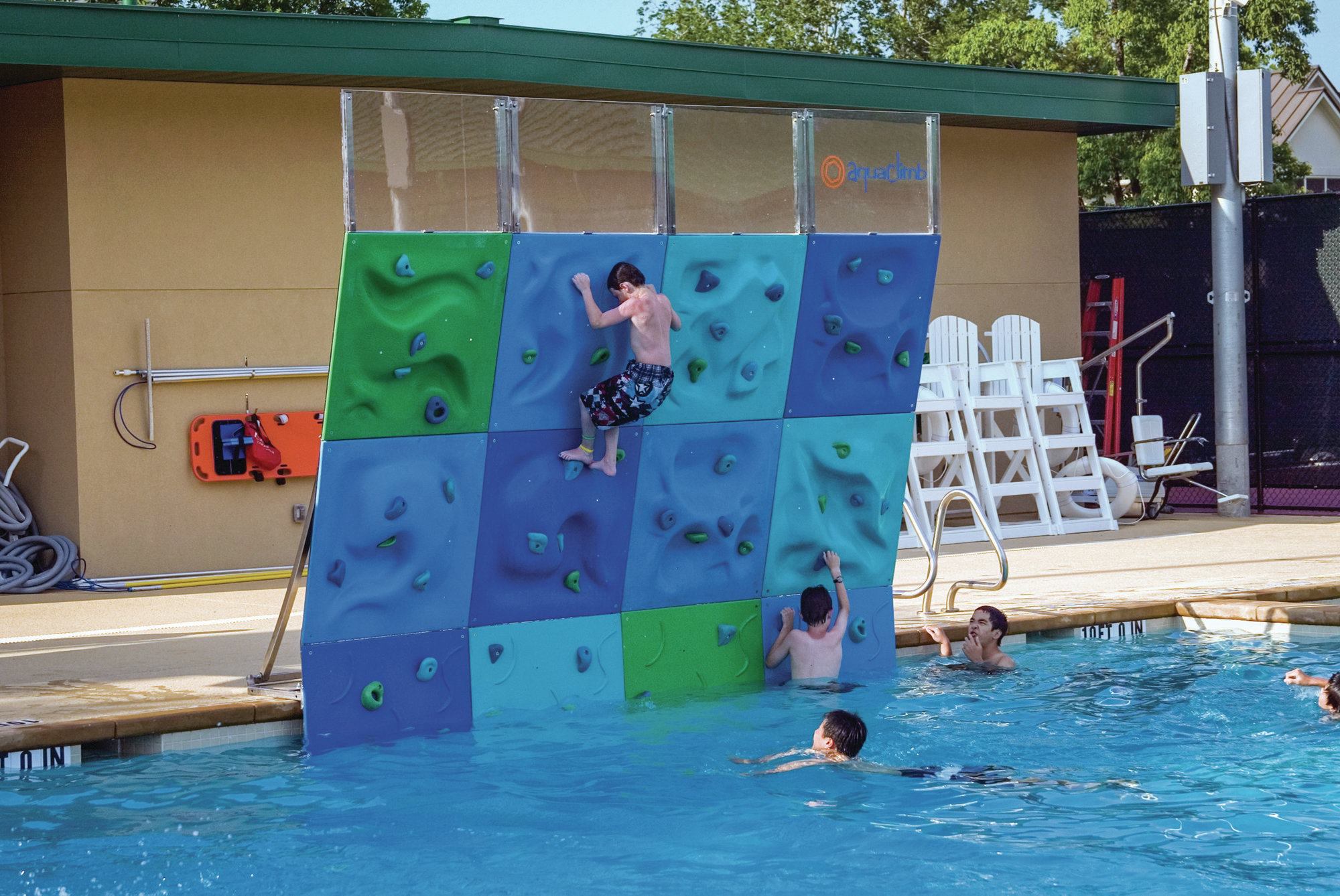Multi-featured pools have been a part of life for commercial aquatics centers and waterparks for decades. But lately that trend has been moving the way of community aquatics.
“We’re seeing a lot of smaller communities with populations under 20,000 where they want to put in an indoor/outdoor leisure pool because they don’t want to travel 100 miles to get to communities that have some,” says Doug Whiteaker, president of Water Technology in Beaver Dam, Wis.
Leisure pools, with their wide array of interactive features, are overtaking the old-fashioned template of lap-type and plain shallow kiddie pools. Here, we discuss how leisure pools are evolving, along with the opportunities and challenges these trends present.
Reaching the hard to reach
Aquatics facilities are forever on the hunt to find ways to attract tweens and teens with features that are more grown up than the spray features enjoyed by the little ones.
“The [challenge] is to try to create something for the hard-to-entertain — the preteens or older — something that they’re not going to do once or twice and get tired of, but something that will draw them back time and again,” says Justin Caron, director of business development and marketing and a project manager with Carlsbad, Calif.-based Aquatic Design Group.
Largely for this reason, designers say, sports features have become increasingly popular. “The biggest trend I’ve seen in the past three to five years is sporting opportunities within the pool — things such as rock climbing walls, zip lines and surfing machines,” says Scott Hester, president of Counsilman-Hunsaker, which is based in St. Louis and has offices in Denver and Los Angeles.
Universities, in particular, have been looking for these features on their student recreation pools for approximately the last decade. “They’re almost, in some cases, a very resort-like experience, and it’s purely for student recruitment,” Hester says. “I’ve heard from a lot of recreation directors who will tell you that when they hold new student recruitment tours, they will, a lot of times, start and stop at the student recreation center. And if they have a really nice pool, they’ll drill it all the way down to the pool deck.”
Not only do these pools help attract students to their universities, but they build an expectation in the student’s mind of what features a pool should contain, which further perpetuates the trend. “When they get themselves out into the community and are looking for aquatic opportunities, that’s their vision of what it should be,” Hester says.
However, incorporating these features on pools can require some strategizing. Zip lines, for instance, need a minimum of approximately 40 feet of length so the user can ride for a few seconds before hitting a bumper and falling into the water.
In the case of climbing walls, temporary products can be a solution. Whereas a permanent climbing wall includes a built structure, often with rockwork, the portable variety can be moved when not in use. They’re attached to the deck with anchors, making them suitable for many existing installations, and they can be placed in deep lap lanes or the diving well when those programs are not in use.
“Another good thing about temporaries is if you have three facilities and you’re a municipality or parks and recreation district, you can move the climbing wall from one to the other on a weekly or biweekly basis so it provides some variety of attraction even within your own park,” Caron says.
If aquatics facility operators know they want to include climbing walls, whether permanent or temporary, Caron suggests trying to create a small alcove in the pool to accommodate it. “Then that alcove can have a fall zone so it doesn’t impact other programs,” he says. “But then when it’s not in use, maybe that alcove also could be used for a lily pad walk, lifeguard training or scuba classes — whatever else you might want to happen in that space. I think the key is really to create a flexible enough space so that if climbing walls are just a passing fad, because they haven’t been around that long in pools, that it’s not going to handicap your facility for years to come.”
With these features, manufacturers often will specify a needed depth and clearance to make sure that those dropping or falling off the features will land safely in enough water.
Aquatics facility owners also should have frank discussions about the liability of some of these features. Climbing walls are more self-contained and angled over the water, so they tend to be on the safer side, Caron says. There seems to be particular concern with zip lines and rope swings because users are less controllable since they can hang on too long and hit something. “It’s always an internal battle between the parks and recreation folk and the city attorneys [as to] what they can do,” Caron says.
With any of these features, friendly competition often is a motivator for use.
In the past, facilities often would duplicate a feature — build two slides side to side, for instance, so users could race. There isn’t room for that anymore on today’s properties, so many facilities are making use of timing systems. They often use sensors at the beginning and end points of the features — say, the top and bottom of the slide — so they can time the users. This also eliminates the need for staff to use a stopwatch.
To make the most of the timers and help foster friendly competition, some facilities will post the best times on a board, challenging everybody to beat it. This is especially easy if users are wearing RFID bracelets, so the user’s identification and time can automatically be posted.
Thinking ahead
While the features available for leisure pools add excitement, users are still quick to become bored and want something new. To meet this need, manufacturers are beginning to offer less permanent options.
In addition to the temporary climbing walls that can be installed or taken away, many new facilities are being designed so certain play features can be exchanged down the road.
“A big trend is the communities that have outdoor splashpads [and] multiple facilities,” Whiteaker says. “Every three to six months, they can take some of the spray features they had at one facility, take it to a different facility and kind of change that facility’s personality.”
To do this, designers should engineer the circulation system to accommodate features that may require different flow rates. Or when making exchanges in the future, operators will need to choose equipment with similar parameters as the old features.
Another option often seen in open water is networks of inflatable features joined together to create aquatic obstacles. “They’re an easy way to generate revenue in a non-revenue-generating space,” Caron says.
Some health departments are resistant to them, he adds, so facility operators must make sure to clear their use.
Road to wellness
In addition to appealing to a younger crowd, aquatics centers also are focusing on exercise equipment as a way to gain users among fitness enthusiasts.
Items such as treadmills, bicycles, rowing machines, steppers and even basic pieces, such as pull-up bars, are making their way into leisure pools. “Basically, anything you can do on dry land you can do in water,” Caron says.
This can present an opportunity to bring in trainers or physical therapists whose patients are covered by Medicare and Medicaid.
But while more and better exercise equipment is becoming available, designers report that any increases in use are modest at this point. While these features and the demographic they serve are desirable, some balk at the logistics involved.
“We’re seeing people talk about [exercise equipment],” Whiteaker says. “There has been certainly a trend of much better and more durable equipment than in the past, but still there’s an issue of how to move that in and out based on [programming].”
Removable equipment does exist, but its storage must be addressed during the design conversation, Caron adds. “There’s never enough storage for pools anyway, and now you’re adding these 6-foot-wide or 6-foot-tall pieces. Where do you put that when it’s not in use?”
When including larger removable exercise equipment in a leisure pool, designers also need to be mindful of the pool and deck surfaces and their durability. “If you have these pieces of equipment going in and out, you’re going to need a deck that’s maybe a little more resilient and a pool floor that’s a little more resilient, so you don’t break your tile, dent your plaster or have it fall off and create some issues,” Caron says.
Because this equipment takes space and consideration, facility owners should have a clear plan about how the equipment will be used. Will the facility sponsor hold classes that are open to the public, or will therapists and trainers use the equipment for their own patients or customers?
Reverse trends?
When it comes to another trend of the last decade or so, the industry may be at a turning point.
For several years, facilities have moved toward more interactive, water-generating features, such as spraypads. But ever-growing concerns with saving costs and preserving the environment also weigh heavily on operators’ minds. Because of this, some are seeing a slight trend away from interactive features, says Steve Brinkel, vice president/general manager of the Parks and Recreation Division for WhiteWater West, in its Denver office.
“There is a direct correlation between the amount of water used and the fun factor,” Brinkel says.
Yet he doesn’t expect it to remain that way permanently. Instead, he predicts that more sustainability-minded products will enter the market. “The market is going to drive manufacturers to provide interactivity at lower water rates,” he says, adding that his company is exploring this possibility.
Another trend that has changed slightly is the type of theming on aquatics facilities, some designers say.
Whereas animated concepts, such as a pirate ships and tropical locales, remain prevalent, some areas are seeing more subtle theming that integrates with the surrounding architecture. “There are certain parts of the country where theme development is important to establish a unique personality for the facility,” says Doug Whiteaker, president of Water Technology in Beaver Dam, Wis. “We’re seeing theming as much more predominant in areas where there’s a plethora of different recreational facilities, so each one has its own personality and creates a desire to go to that facility.”
He adds that “theming doesn’t necessarily have to mean rock and waterfalls, it can be done with the architectural vernacular, so the whole facility has a seamless approach.”
Facilities are choosing to do this in less permanent ways as well, he says. Graphics on a wall can set the tone, rather than creating the equipment to fit a theme.
Facilities haven’t wavered in their commitment to take the experience beyond the pool coping and create a pleasing aesthetic, says Scott Hester, president of Counsilman-Hunsaker, which is based in St. Louis and has offices Denver and Los Angeles. But they and their designers are thinking more long term. “I prefer theming to be subtle because when you take the theming to the point where it’s a pirate theme or a sport theme, you’re risking the chance that you might begin to date that facility 10 years down the road,” he says. “So [I prefer] theming through colors, signage and landscaping [as opposed to] heavy theming with structures or even the aquatic amenities themselves. It’s easier to even add or expand and you’re not necessarily stuck with a very rigorous and specific theme.”



